| UNESCO World Heritage Site | |
|---|---|
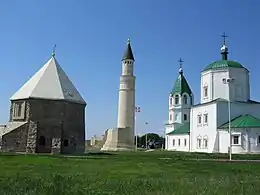 | |
| Official name | Bolgar Historical and Archaeological Complex |
| Location | Tatarstan, Russia |
| Criteria | Cultural: (ii), (vi) |
| Reference | 981rev |
| Inscription | 2014 (38th Session) |
| Area | 424 ha (1.64 sq mi) |
| Buffer zone | 12,101 ha (46.72 sq mi) |
| Coordinates | 54°58′44″N 49°03′23″E / 54.97889°N 49.05639°E |
 Location of Bolghar in Russia | |
Bolghar (Kypchak and Bulgar: بلغار, Tatar: Болгар, Chuvash: Пăлхар) was intermittently the capital of Volga Bulgaria from the 10th to the 13th centuries, along with Bilyar and Nur-Suvar. It was situated on the bank of the Volga River, about 30 km downstream from its confluence with the Kama River and some 130 km from modern Kazan in what is now Spassky District. West of it lies a small modern town, since 1991 known as Bolgar. The UNESCO World Heritage Committee inscribed Bolgar Historical and Archaeological Complex (ancient Bolghar hill fort) to the World Heritage List in 2014.[1]

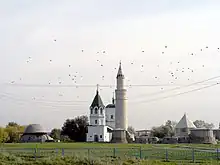
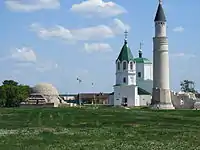
History
The city is supposed to have been the capital of Volga Bulgaria from as early as the 10th century. Regular Kievan Rus' incursions along the Volga, and internecine fights, forced the Volga Bulgar kings (khagans) to intermittently move their capital to Bilyar.
During the Mongol invasion of Volga Bulgaria in the 13th century, the Golden Horde conquered the realm. After a destruction of Bilyar during the Mongol invasion, the older capital became a centre of a separate province (or duchy) within the Golden Horde. It lay outside the ulus itself, but had direct Mongol presence.[2] The Mongols eliminated the existing socio-political structure of the Volga Bolgars.[2] During the period of Mongol domination Bolgar acquired immense wealth and many imposing buildings and grew tenfold in size. The taxation of regions such as Bolgar, Khwarizm, Crimea and Azerbaijan filled the Golden Horde's coffers with great wealth, and the Mongols replaced the sitting rulers of Bolgar and Khwarizm with their own, while the Rus' principalities in the west brought them comparatively little revenue, and they left the local princes in Rus', Armenia and Georgia in charge.[2]
The late 14th century saw a marked decline in its fortunes. It was sacked by Bulat-Timur in 1361 during the Great Troubles. The Muscovite–Volga Bulgars war (1376) saw Muscovy and Nizhny Novgorod-Suzdal briefly capture Grand Bolgar and installing their own doroga and tamozhnia (customs collector), which probably were existing offices at the time, before the Tatars retook the city.[3] It was endangered by Timur during the Tokhtamysh–Timur war. As a Muslim religious center Bolgar persevered until the mid-16th century when the Khanate of Kazan was conquered by the Russian Tsar Ivan IV and incorporated into the Russian state.
During Tsarist rule the site of the ancient town was settled by Russian commoners. Tsar Peter the Great issued a special ukase to preserve the surviving ruins, which was the first Russian law aimed at preserving historical heritage.
Little pilgrimage
During the Soviet period, Bolgar was a center of a local Islamic movement known as The Little Hajj; Muslims from Tatarstan and other parts of the Soviet Union could not participate in the hajj to Mecca, so they travelled instead to Bolgar.
Monuments and temples
 Eastern mausoleum
Eastern mausoleum Khans' mausoleum
Khans' mausoleum Northern mausoleum
Northern mausoleum Black Chamber
Black Chamber White Chamber
White Chamber Big manara
Big manara Small manara
Small manara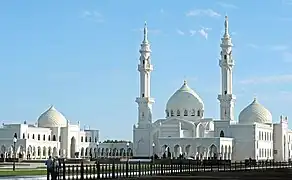 New Bolghar White Mosque
New Bolghar White Mosque
Importance
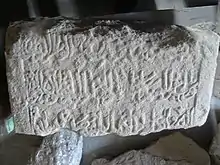
The Tatars refer to the medieval capital of Volga Bolgaria as Shahri Bolghar (Tatar: Шәһри Болгар), that is Persian for "the City of Bolghar". The town is part of their cultural heritage, because Volga Bulgaria is the predecessor state of the Khanate of Kazan, which in turn is in a way the predecessor of today's Russian republic of Tatarstan.
Today, the capital of Tatarstan is Kazan, but many Tatars consider Bolghar to be their ancient and religious capital and to allow a glimpse of Muslim Bulgar life before the Mongol invasion of Volga Bulgaria.
References
- Edward Tracy Turnerelli, Kazan, the Ancient Capital of the Tartar Khans, 1854, pp 196–261
- Halperin, Charles J. (1987). Russia and the Golden Horde: The Mongol Impact on Medieval Russian History. p. 222. ISBN 9781850430575. (e-book).
- ↑ "Bolgar Historical and Archaeological Complex". UNESCO World Heritage Centre. Retrieved 2019-08-09.
- 1 2 3 Halperin 1987, p. 47.
- ↑ Halperin 1987, p. 57.
External links
 Media related to Bolghar ancient settlement at Wikimedia Commons
Media related to Bolghar ancient settlement at Wikimedia Commons